Application of laser radiation
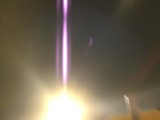 Laser — a quantum generator (amplifier) of coherent radiation in the optical range. The term «laser» is formed from the first letters of the English name amplification of light by stimulated emission of radiation. Depending on the type of active material, a distinction is made between solid-state lasers, gas and liquid lasers.
Laser — a quantum generator (amplifier) of coherent radiation in the optical range. The term «laser» is formed from the first letters of the English name amplification of light by stimulated emission of radiation. Depending on the type of active material, a distinction is made between solid-state lasers, gas and liquid lasers.
Of the lasers of the first type, ruby is the most studied. One of the earliest models of such a laser uses energy transitions of the trivalent chromium ion Cr3+ in a monolithic ruby crystal (Cr2O3, A12O3). Under the action of pumping radiation (with a wavelength of the order of 5600 A), the Cr3+ ion passes from level 1 to level 3, from which downward transitions to levels 2 and 1 are possible. If transitions to metastable level 2 predominate and if pumping provides post, the inversion of the population at levels 1 and 2, then the population at level 2 will exceed the population at level 1.
In the case of a spontaneous transition of one of the Cr-ions3+, a photon with frequency is emitted from level 2 to level 1 e12, which begins to propagate on the ruby crystal.Encountering d -red excited Cr3+ ions, this photon causes already induced radiation coherent with the primary photon.
Due to numerous reflections from the polished and silvered edges of the ruby single crystal, the radiation intensity in the crystal is continuously increased. This happens only with those photons, the direction of propagation is komotorykh makes a small angle with the axis of the crystal. The steel radiation leaves the crystal through the side surface and does not participate in the formation of the radiation beam. The radiation beam exits through one of the ends, which is a translucent mirror.
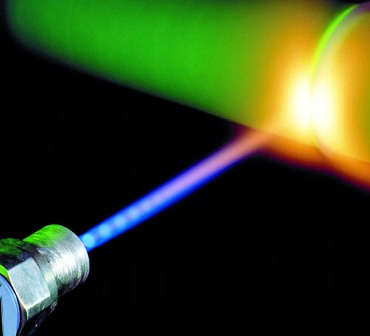
A major advance in the improvement of technology in various industries is related to the use of optical quantum generators (lasers). As you know, laser radiation differs significantly from the radiation of other non-laser light sources (thermal, gas discharge, etc.). These differences have led to the widespread use of lasers in various fields of science and technology.
Consider the basic design of lasers.
In general, the block diagram of an optical quantum generator (OQC) is shown in Fig. 1 (in some cases drives 4-7 may be missing).
In the active substance 1, under the action of pumping, the radiation passing through it is enhanced due to the induced (caused by an external electromagnetic field) radiation of electrons passing from the upper energy levels to the lower ones. In this case, the properties of the active substance determine the laser emission frequency.
As an active substance, crystalline or amorphous media can be used, in which small amounts of impurities of active elements are introduced (in solid-state lasers); gases or vapors of metals (in gas lasers); liquid solutions of organic dyes (in liquid lasers).
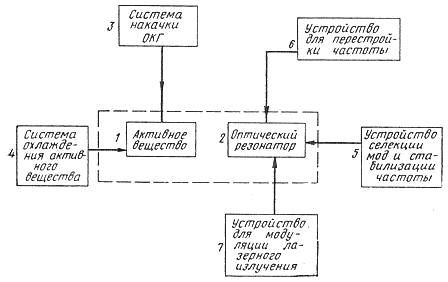
Rice. 1. Block diagram of an optical quantum generator
With the help of the laser pump system 3, conditions are created in the active substance, which makes it possible to amplify the radiation. For this, it is necessary to create an inversion (redistribution) of the populations of the energy levels of the atoms of electrons, in which the population of the upper levels is greater than that of the lower ones. As pumping systems, they are used in solid-state lasers — gas discharge lamps, in gas lasers — direct current sources, pulsed, HF and microwave generators, and in liquid lasers — LAGs.
The active substance of the laser is placed in an optical resonator 2, which is a system of mirrors, one of which is translucent and serves to remove laser radiation from the resonator.
The functions of the optical resonator are quite diverse: creating positive feedback in the generator, forming the spectrum of laser radiation, etc.
The device 5 for mode selection and frequency stabilization is designed to improve the quality of the spectrum of the output radiation of the laser, i.e. to bring it closer to the spectrum of monochromatic oscillations.
In liquid lasers, System 6 achieves a wide range of oscillation frequency tuning. If necessary, amplitude or phase modulation of the radiation can be achieved in the laser. External modulation is usually used with device 7.
Laser types
Modern lasers can be classified according to different criteria:
• by the type of active substance used in them,
• by operating mode (continuous or pulsed generation, Q-switched mode),
• by spectral properties of the radiation (multi-mode, single-mode, single-frequency lasers), etc.
The most common is the first of the mentioned classifications.
Solid state lasers
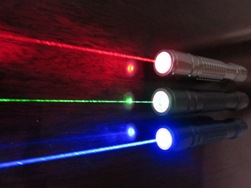 These lasers use crystalline and amorphous media as the active substance. Solid-state lasers have a number of advantages:
These lasers use crystalline and amorphous media as the active substance. Solid-state lasers have a number of advantages:
• high values of the linear gain of the medium, which make it possible to obtain a laser with small axial dimensions of the laser;
• possibility of obtaining extremely high output power values in pulse mode.
The main types of solid state lasers are:
1. ruby lasers in which chromium ions are the active center. The generating lines lie in the red region of the spectrum (λ = 0.69 μm). The output power of the radiation in continuous mode is several watts, the energy in pulsed mode is several hundred joules with a pulse duration of the order of 1 ms;
2. lasers based on rare earth metal ions (mainly neodymium ions). An important advantage of these lasers is the ability to be used in continuous mode at room temperature. The main generation line of these lasers is in the infrared region (λ = 1.06 μm). The output power level in continuous mode reaches 100-200 W with an efficiency of 1-2%.
Gas lasers
Population inversion in gas lasers is achieved both with the help of discharges and with the help of other types of pumping: chemical, thermal, etc.
Compared to solid-state gas lasers, they have a number of advantages:
• covers an extremely wide range of wavelengths 0.2-400 microns;
• the emission of gas lasers is highly monochromatic and directional;
• enable very high output power levels to be achieved in continuous operation.
The main types of gas lasers:
1.Helium neon lasers… The main wavelength is in the visible part of the spectrum (λ = 0.63 μm). The output power is usually less than 100 mW. Compared to all other types of lasers, helium-neon lasers provide the highest degree of output coherence.
2. Copper vapor lasers… The main generation of radiation is created on two lines, one of which is in the green part of the spectrum (λ = 0.51 μm) and the other in the yellow (λ = 0.58 μm). The pulse power in such lasers reaches 200 kW with an average power of about 40 W.
3. Ion gas lasers... The most common lasers of this type are argon lasers (λ = 0.49 — 0.51 µm) and helium-cadmium lasers (λ = 0.44 µm).
4. Molecular CO2 lasers... The most powerful generation is achieved at λ = 10.6 μm. The output power in the cw mode of CO2 lasers is extremely high and reaches 10 kW or more with a sufficiently high efficiency of 15-30% compared to all other types of lasers. Pulse powers = 10 MW are achieved with a duration of the generated pulses of the order of 10-100 ms.
Liquid lasers
Liquid lasers allow tuning over a wide range of the generated oscillation frequency (from λ = 0.3 µm to λ = 1.3 µm). As a rule, in such lasers, the active substance is liquid solutions of organic dyes (for example, rhodamine solution).
Laser parameters
Coherence
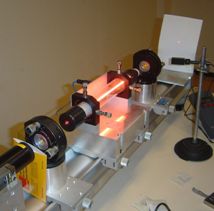 A distinctive feature of laser radiation is its coherence.
A distinctive feature of laser radiation is its coherence.
Coherence is understood as a coordinated course of wave processes in time and space. Spatial coherence — the coherence between the phases of the waves emitted simultaneously from different points in space, and temporal coherence — the coherence between the phases of the waves emitted from one point in the moments of a break in time.
Coherent electromagnetic oscillations — oscillations of two or more sources with the same frequencies and a constant phase difference. In radio engineering, the concept of coherence also extends to sources of oscillations whose frequencies are not equal. For example, the oscillations of 2 sources are considered coherent if their frequencies f1 and e2 are in a rational relationship, i.e. f1 / f2 = n / m, where n and m are integers.
Sources of oscillations that in the observation interval have almost equal frequencies and almost the same phase difference, or sources of oscillations whose frequency ratio differs little from the rational one, are called sources of almost coherent oscillations.
The ability to interfere is one of the main characteristics of coherent oscillation. It should be noted that only coherent waves can interfere. In the following, it will be shown that a number of fields of application of optical radiation sources are based precisely on the phenomenon of interference.
Divergence
The high spatial coherence of the laser radiation leads to a low divergence of this radiation, which depends on the wavelength λ and the parameters of the optical cavity used in the laser.
For ordinary light sources, even when special mirrors are used, the divergence angle is about one to two orders of magnitude larger than that of lasers.
The low divergence of the laser radiation opens up the possibility of obtaining a high flux density of light energy using conventional focusing lenses.
The high directivity of laser radiation makes it possible to carry out local (practically at a given moment) analyses, measurements and effects on a given substance.
In addition, the high spatial concentration of laser radiation leads to pronounced nonlinear phenomena, in which the nature of the ongoing processes depends on the intensity of the irradiation. As an example, we can point to multiphoton absorption, which is observed only when using laser sources and leads to an increase in energy absorption by matter at high emitter powers.
Monochrome
The degree of monochromaticity of the radiation determines the frequency range in which the main part of the power of the emitter is contained. This parameter is of great importance when using sources of optical radiation and is entirely determined by the degree of temporal coherence of the radiation.
In lasers, all radiation power is concentrated in extremely narrow spectral lines. The small width of the emission line is achieved by using an optical resonator in the laser and is mainly determined by the stability of the resonance frequency of the latter.
Polarization
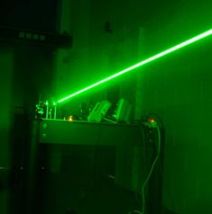 In a number of devices, a certain role is played by the polarization of the radiation, which characterizes the predominant orientation of the vector of the electric field of the wave.
In a number of devices, a certain role is played by the polarization of the radiation, which characterizes the predominant orientation of the vector of the electric field of the wave.
Common non-laser sources are characterized by chaotic polarization. Laser radiation is circularly or linearly polarized. In particular, with linear polarization special devices can be used to rotate the plane of polarization. In this regard, it should be noted that for a number of food products the reflection coefficient within the absorption band depends significantly on the direction of the plane of polarization of the radiation.
Pulse duration. The use of lasers also makes it possible to obtain radiation in the form of pulses of very short duration (tp = 10-8-10-9 s). This is usually achieved by modulating the Q-factor of the resonator, mode locking, etc.
In other types of radiation sources, the minimum pulse duration is several orders of magnitude higher, which, in particular, is thus the width of the spectral line.
Effects of laser radiation on biological objects
Laser radiation with high energy density in combination with monochromaticity and coherence is a unique factor affecting biological objects. Monochromaticity makes it possible to selectively affect certain molecular structures of objects, and coherence and polarization, combined with a high degree of organization of irradiated systems, determine a specific cumulative (resonance) effect, which even at relatively low levels of radiation leads to strong photostimulation of processes in cells, to photomutagenesis.
When biological objects are exposed to laser radiation, some molecular bonds are destroyed or the structural transformation of molecules occurs, and these processes are selective, that is, some bonds are completely destroyed by irradiation, while others practically do not change. Such a pronounced resonance character of the interaction of laser radiation with molecules opens the possibility of selective catalysis of certain metabolic reactions, that is, metabolic reactions, light control of these reactions. In this case, laser radiation plays the role of an enzyme.
The use of such properties of laser light sources opens wide possibilities for enhancing industrial biosynthesis.
Laser irradiation of yeast can be used for targeted biosynthesis of, for example, carotenoids and lipids, and more broadly, to obtain new mutant yeast strains with altered biosynthetic orientation.
In a number of food industries, the ability to control, using laser irradiation, the activity ratio of enzymes that break down protein molecules into polypeptide fragments and hydrolyze these fragments into amino acids can be used.
In the industrial production of citric acid, laser stimulation achieves an increase in product yield by 60% and at the same time reduces the content of by-products. Laser photostimulation of lipogenesis in fungi enables the production of edible and technical fats during the processing of inedible mushroom raw materials. Data were also obtained on laser stimulation of the formation of reproductive organs in fungi used in the microbiological industry.
It should be noted that, unlike conventional light sources, the laser is able to sterilize juices in the visible part of the spectrum, which opens the possibility of sterilization using lasers directly through the glass of the bottle.
An interesting feature of laser sterilization has been noted. If at a low power level the survival curves of microbial cells for laser irradiation and irradiation with a conventional light source practically coincide, then when the specific power of laser irradiation is about 100 kW / cm2, there is a sharp increase in the effectiveness of the sterilizing action of laser radiation , i.e. to achieve the same effect of cell death requires much less energy than using a low power source.
When irradiated with an incoherent light source, this effect is not observed. For example, when the cells are illuminated with a powerful pulse, one flash is enough for the ruby laser to hit up to 50% of the cells, while the same energy, absorbed for a long time, not only does not cause damage, but also leads to the intensification of processes of photosynthesis in microorganisms.
The described effect can be explained by the fact that, under normal conditions, molecules entering into a photochemical reaction absorb one quantum of light (one-photon absorption), which increases their reactivity. At high levels of incident radiation, the probability of two-photon absorption increases, in which a molecule absorbs two photons simultaneously. In this case, the efficiency of chemical transformations increases sharply and the structure of molecules is damaged with greater efficiency.
When exposed to powerful laser radiation, other nonlinear effects occur that are not observed when using conventional light sources. One of these effects is the conversion of part of the radiation power of frequency f into radiation of frequencies 2f, 3f, etc. (generation of optical harmonics). This effect is due to the non-linear properties of the irradiated medium at high irradiation levels.
Since it is known that biological objects are most sensitive to the action of UV radiation, the sterilizing effect of harmonics will be most effective. At the same time, if an object is irradiated directly with a source of UV radiation, most of the incident power of the emitter will be absorbed in the surface layers. In the described case, the UV radiation is generated inside the object itself, which leads to the volumetric nature of the sterilizing effect. Obviously, in this case, greater efficiency of the sterilization process can be expected.
The high degree of monochromaticity of laser radiation can make it possible to sterilize one type of bacteria, while stimulating the growth of microorganisms of another type in binary bacterial systems, that is, to produce targeted "selective" sterilization.
In addition to these areas of application, lasers are also used to measure various quantities — spectroscopy, displacements of objects (interference method), vibrations, flow velocities (laser anemometers), inhomogeneities in optically transparent media. With the help of lasers, it is possible to monitor the quality of the surface, to study the dependence of the optical properties of a given substance on external factors, to measure the contamination of the environment with microorganisms, etc.
